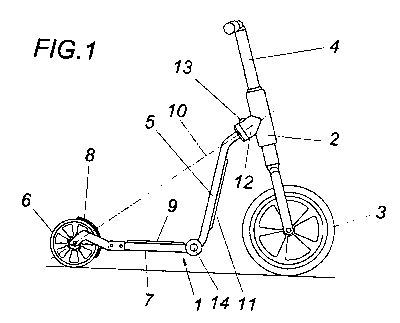Une partie des informations de ce site Web a été fournie par des sources externes. Le gouvernement du Canada n'assume aucune responsabilité concernant la précision, l'actualité ou la fiabilité des informations fournies par les sources externes. Les utilisateurs qui désirent employer cette information devraient consulter directement la source des informations. Le contenu fourni par les sources externes n'est pas assujetti aux exigences sur les langues officielles, la protection des renseignements personnels et l'accessibilité.
L'apparition de différences dans le texte et l'image des Revendications et de l'Abrégé dépend du moment auquel le document est publié. Les textes des Revendications et de l'Abrégé sont affichés :
| (12) Demande de brevet: | (11) CA 2859204 |
|---|---|
| (54) Titre français: | TROTTINETTE |
| (54) Titre anglais: | SCOOTER |
| Statut: | Réputée abandonnée et au-delà du délai pour le rétablissement - en attente de la réponse à l’avis de communication rejetée |
| (51) Classification internationale des brevets (CIB): |
|
|---|---|
| (72) Inventeurs : |
|
| (73) Titulaires : |
|
| (71) Demandeurs : |
|
| (74) Agent: | ROBIC AGENCE PI S.E.C./ROBIC IP AGENCY LP |
| (74) Co-agent: | |
| (45) Délivré: | |
| (86) Date de dépôt PCT: | 2012-12-12 |
| (87) Mise à la disponibilité du public: | 2013-06-27 |
| Licence disponible: | S.O. |
| Cédé au domaine public: | S.O. |
| (25) Langue des documents déposés: | Anglais |
| Traité de coopération en matière de brevets (PCT): | Oui |
|---|---|
| (86) Numéro de la demande PCT: | PCT/AT2012/000317 |
| (87) Numéro de publication internationale PCT: | WO 2013090953 |
| (85) Entrée nationale: | 2014-06-13 |
| (30) Données de priorité de la demande: | ||||||
|---|---|---|---|---|---|---|
|
L'invention concerne une trottinette dotée d'un châssis (1) comportant un palier de guidage (2), destiné à une colonne de direction (4) recevant la roue avant (3), et un bras de support (5) comprenant un siège (11) et destiné à un marchepied (7) pivotant pourvu d'une roue arrière (8). L'invention vise à permettre de transformer facilement cette trottinette en draisienne. A cet effet, le bras de support (5) relié au marchepied (7) est articulé sur le palier de guidage (2) de manière à pouvoir pivoter autour d'un axe (10) passant par le centre de la roue arrière (8).
A scooter is described with a chassis (1) which has a guide bearing (2) for a steering column (4) holding the front wheel (3) and a supporting arm (5), which has a seat (11), for a pivotable footboard (7) which is provided with a rear wheel (8). In order to achieve simple readjustment to a training bike, it is proposed that the supporting arm (5) which is connected to the footboard (7) is coupled to the guide bearing (2) so as to be pivotable about an axis (10) running through the centre point of the rear wheel (8).
Note : Les revendications sont présentées dans la langue officielle dans laquelle elles ont été soumises.
Note : Les descriptions sont présentées dans la langue officielle dans laquelle elles ont été soumises.

2024-08-01 : Dans le cadre de la transition vers les Brevets de nouvelle génération (BNG), la base de données sur les brevets canadiens (BDBC) contient désormais un Historique d'événement plus détaillé, qui reproduit le Journal des événements de notre nouvelle solution interne.
Veuillez noter que les événements débutant par « Inactive : » se réfèrent à des événements qui ne sont plus utilisés dans notre nouvelle solution interne.
Pour une meilleure compréhension de l'état de la demande ou brevet qui figure sur cette page, la rubrique Mise en garde , et les descriptions de Brevet , Historique d'événement , Taxes périodiques et Historique des paiements devraient être consultées.
| Description | Date |
|---|---|
| Inactive : Morte - RE jamais faite | 2018-12-12 |
| Demande non rétablie avant l'échéance | 2018-12-12 |
| Requête pour le changement d'adresse ou de mode de correspondance reçue | 2018-12-04 |
| Inactive : Abandon.-RE+surtaxe impayées-Corr envoyée | 2017-12-12 |
| Requête visant le maintien en état reçue | 2014-11-26 |
| Inactive : Page couverture publiée | 2014-09-09 |
| Inactive : Notice - Entrée phase nat. - Pas de RE | 2014-08-15 |
| Demande reçue - PCT | 2014-08-15 |
| Inactive : CIB en 1re position | 2014-08-15 |
| Inactive : CIB attribuée | 2014-08-15 |
| Inactive : CIB attribuée | 2014-08-15 |
| Exigences pour l'entrée dans la phase nationale - jugée conforme | 2014-06-13 |
| Demande publiée (accessible au public) | 2013-06-27 |
Il n'y a pas d'historique d'abandonnement
Le dernier paiement a été reçu le 2017-11-14
Avis : Si le paiement en totalité n'a pas été reçu au plus tard à la date indiquée, une taxe supplémentaire peut être imposée, soit une des taxes suivantes :
Veuillez vous référer à la page web des taxes sur les brevets de l'OPIC pour voir tous les montants actuels des taxes.
| Type de taxes | Anniversaire | Échéance | Date payée |
|---|---|---|---|
| Taxe nationale de base - générale | 2014-06-13 | ||
| TM (demande, 2e anniv.) - générale | 02 | 2014-12-12 | 2014-11-26 |
| TM (demande, 3e anniv.) - générale | 03 | 2015-12-14 | 2015-11-19 |
| TM (demande, 4e anniv.) - générale | 04 | 2016-12-12 | 2016-10-17 |
| TM (demande, 5e anniv.) - générale | 05 | 2017-12-12 | 2017-11-14 |
Les titulaires actuels et antérieures au dossier sont affichés en ordre alphabétique.
| Titulaires actuels au dossier |
|---|
| SCOOT & RIDE GMBH |
| Titulaires antérieures au dossier |
|---|
| ROBERT KIRCHSCHLAGER |
| WOLFGANG BERNDORFER |